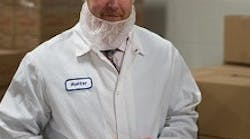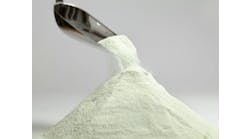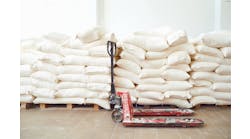Hunter Malcolm, president of Dure Foods, Brantford, Ontario. Photo: Nabil Shash
Just as machine-based processing lacks the flexibility of manual production but makes up for it in throughput, manual processes provide infinite flexibility but come with a loss in volume. Finding the sweet spot between the extremes is the world most food manufacturers live in.
Management at Dure Foods Ltd. has been engaged in that balancing act for most of its 38 years in business. The Brantford, Ontario-based copacker of dry blends does contract work for some of Canada’s biggest retailers and some of the world’s largest food manufacturers, but a good chunk of Dure’s production schedule is filled with orders from entrepreneurs and mid-sized food companies.
“The mixing of powders is not rocket science,” President Hunter Malcolm readily admits. But mastering best practices in packaging and production and the details of food safety and regulatory requirements requires more than a little expertise. “A lot of my time is spent on helping (smaller) customers to understand the details involved and being slow and methodical” when preparing for production runs.
Dure was founded by his father, Scott Malcolm, a onetime Dean Foods salesman who rented space in a warehouse where he set up a table to manually fill containers of liquid soap. When his employer gave him an order to fill packets of coffee whitener, nondairy creamers and sugar, he purchased a Hayssen vertical form, fill and seal (f/f/s) machine and segued to human consumables.
The company never looked back. Powdered cappuccino and hot chocolate mixes followed, and by 2000 a supplier relationship had been established with Tim Hortons, the ubiquitous coffee and baked goods purveyor that dominates Canada’s fast-food category and was acquired by Burger King two years ago.
The Horton relationship led to construction of a 35,000-sq.-ft. packaging facility in 2002 (expanded to 55,000 sq. ft. in 2006) and a “mirror image” facility in Columbus, Ohio, in 2005 (combined annual capacity: 70 million lbs.). Along the way, blending and packaging capabilities for functional foods and other more complex formulations were added.
Production runs of 24/7 for several months are required for some high-volume orders, but short runs are more the rule. As few as 1,000 single-serve stick packs for sampling purposes have been run. The casters on many machine skids attest to the line reconfigurations that occur on a regular basis.
The coin’s other side
Contrast Dure’s nimbleness to most snack-food plants. With projected annual compounded growth of 2.9 percent over the next six years, snacks — salty and otherwise -- are among the food industry’s pacesetters. Increased throughput through automation is necessary, yet manual processes still have a place at many high-volume plants.
Mark Lozano, national sales manager at Coppell, Texas-based TNA North America, cites the example of Shearer’s Foods, a Massillon, Ohio, chip manufacturer with eight production facilities. Besides its own brand, Shearer’s produces private label products and is part of the Frito-Lay network. Given frequent changeovers, casepacking is a manual process, a common scenario in snack factories.
Top end speed for a casepacking machine is approximately 140 bags per minute (bpm), according to Lozano, slower than the fill rate for extruded products and well below thresholds for the fastest vertical f/f/s machines. Hinting at a breakthrough casepacker from TNA, Lozano says fully automated secondary packaging remains out of reach for most snack firms.
Pillow pouches are the latest packaging option at Dure Foods. Until order volume justifies automation, case packing and palletizing will remain manual.
High-speed f/f/s machines capable of a range of bag sizes are TNA’s hallmark — a triple-jaw machine tops out at 320 bpm, Lozano says — but the machine builder’s focus has shifted to the entire production and packaging lines. The firm acquired several OEMs of fryers, coating machines and other equipment in recent years, but one of its key acquisitions involved Cadalec Group, a systems integrator in Leicester, UK. Tying together upstream vibratory conveyors and downstream scales, metal detectors and other equipment is automation’s version of flexibility.
Manufacturer preference dictates control architecture, which is why a PLC integrates machine functions in a recent project at the Algerian snack company Maravilla. But the preference is PC-based controls, Lozano says. “It’s really whatever the customer is comfortable with,” but PCs are more adaptable than industrial PLCs.
Mislabeled product is a leading cause of product recalls. Copackers are particularly vulnerable, given the number of changeovers they make. An optional code reader can be integrated into film feeders to scan the printed codes on the film feeding TNA’s machine. If the code doesn’t match the job order for product entering the f/f/s unit, the machine automatically stops and queries the operator, according to Lozano.
Product comes off a pretzel line faster than it does at Dure Foods, but similar fail-safe controls are in place. Six years ago the firm received a grant from the provincial government to participate in a traceability demonstration project. Paper logs of processing steps still are kept, but they are redundant to the electronic records captured by the traceability software.
Independent lab tests for coliform bacteria, salmonella and other food safety markers are conducted after bulk ingredient blending and post-finished goods packaging. Until the lab returns a negative result, nothing moves to packaging or to finished-goods inventory. “The system doesn’t let us take an SKU out of sequence and before it’s cleared,” says Malcolm. “We can’t even print a packing slip before a product is cleared.”
Batch sizes up to 1,600kg/3,520 lbs. are blended in Dure’s ribbon blenders and transported to one of four packaging rooms, where 20 different jobs are run on a typical day. The can room, where tins and plastic bottles are filled, was set up when the building was occupied. The stick-pack room was commissioned in 2015; X-ray inspection is required because of the metalized film needed for oxygen and UV protection for dairy-based ingredients.
Pouch filling capabilities were added this year, with 2 lb. pouches of whey protein the most frequent application. Plastic jugs are the most commonly used containers for that product, Malcolm allows, but he opted for pouches because of the minimal storage space required for unfilled packages, as compared to jugs.
Those three packaging rooms can be described as semi-automated: Checkweighing is done manually on a periodic basis, and end-of-line casepacking and palletizing are done by hand. Throughput limitations didn’t prevent the world’s largest food company from contracting with Dure to build a fourth packaging area, a dedicated clean room within the plant. Sealed conduit, no hollow tubing, positive air pressure with HEPA filtration and other features consistent with the client’s food safety standards were incorporated into the enclosed space.
When the client was seeking a manufacturing partner, other copackers quoted 18-month lead times, according to Tim Laberge, plant manager. Dure delivered on a promise to be up and running in 3½ months.
“We’re very nimble; we can turn on a dime,” says Malcolm with a hint of pride. “That’s very helpful for some customers,” regardless of size.


